“Farmers are notorious for not liking paperwork but it does have its uses.”
I’m speaking with Co Galway farmer Blátnaid Gallagher and her husband Niall.
We’re picnicking in one of their fields near the historic village of Aughrim, drinking strong tea from a flask and eating scones with cream and jam.
As we eat, their inquisitive flock of Galway sheep (freshly shorn) are approaching – wondering if they might get a bite of scone, as well.
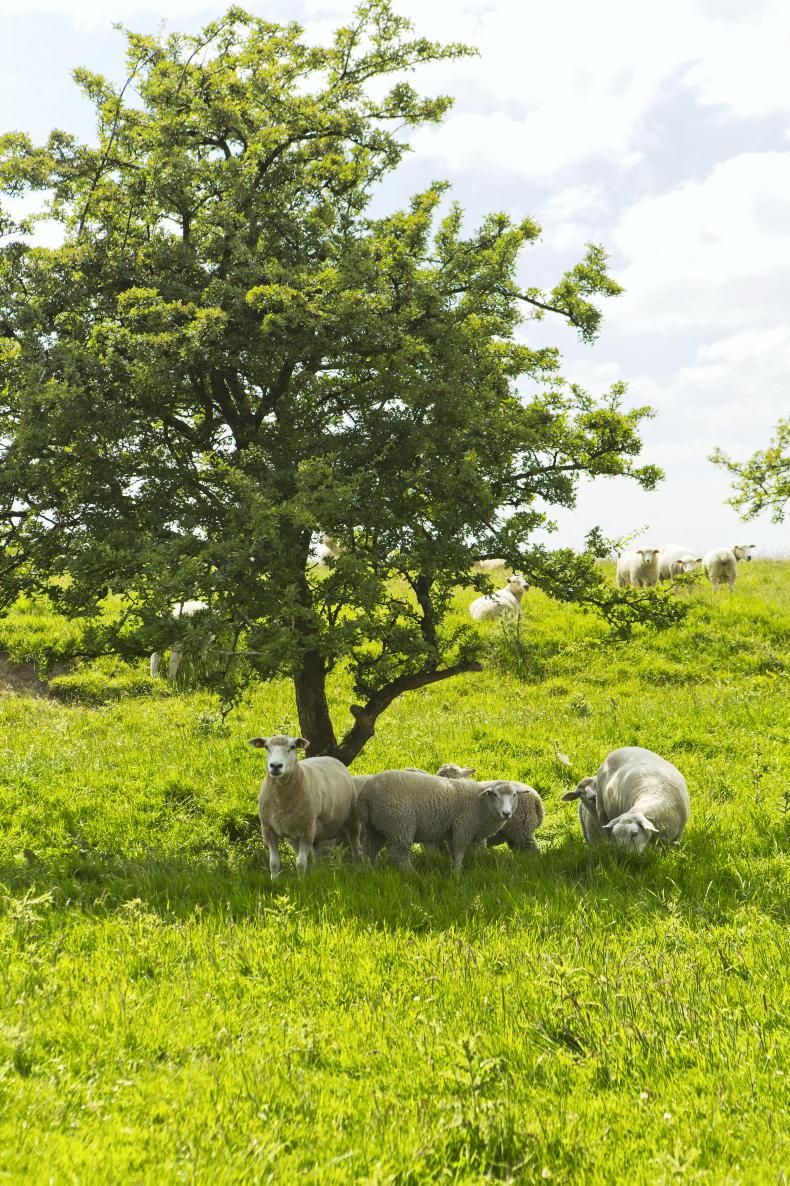
Galway sheep don't tend to wander, making them ideal for pasture grazing. \ David Ruffles
Yes, paperwork can be boring but for a native Irish breed it’s the raison d’être. Galway sheep, with their pleasant nature and cute hair-dos, have been meticulously documented for over 100 years; proving a clear lineage and existence. Blátnaid started farming her “Galway girls” five years ago and she is a passionate advocate for the breed and its continued survival.
A native Irish breed
She says, historically, there were two main groups of sheep native to Ireland: one prevalent in the uplands, and the other in the lowland plains.
However, the Galway sheep is currently the only listed native breed in the eyes of the Department of Agriculture and the Marine (DAFM), as its ancestry can be tracked over several generations through the Galway Sheep Breeders Association (established in 1923).
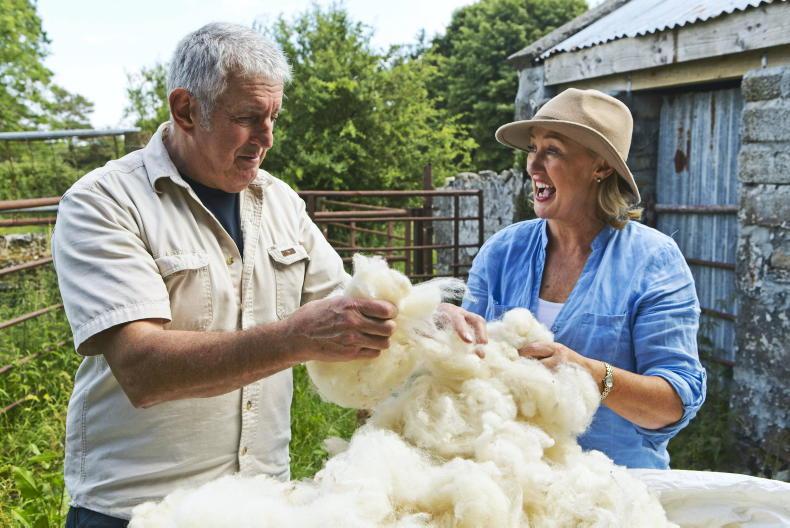
Blátnaid and Niall are meticulous about how their sheep are sheared. \ David Ruffles
“There was a breed of sheep that was predominant over the plains of Ireland (the lowland sheep),” she says. “In the early 19th century, a group of farmers in Roscommon got together and formed the first flock book of Irish lowland sheep breed, called the Roscommon.
“However,” she continues, “they didn’t pursue it and that flock book was lost. In 1923, a group of farmers in Galway got their own flock book together. So, the Roscommon disappeared – and it’s highly likely the Roscommon and the Galway are the same lowland Irish sheep. Because the Galway flock book was maintained, it’s the Galway which has the recognition of a native Irish breed.”
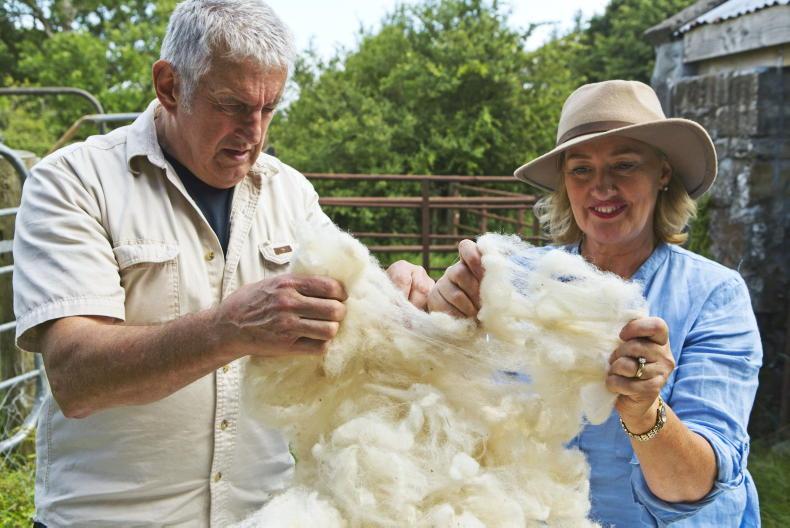
The Galway wool is bright white and extremely soft. \ David Ruffles
Galway Sheep Breeders Association
Blátnaid became involved in the Galway Sheep Breeders Association when she started keeping her own Galways. She inherited her family farm, which is over 100ac in size.
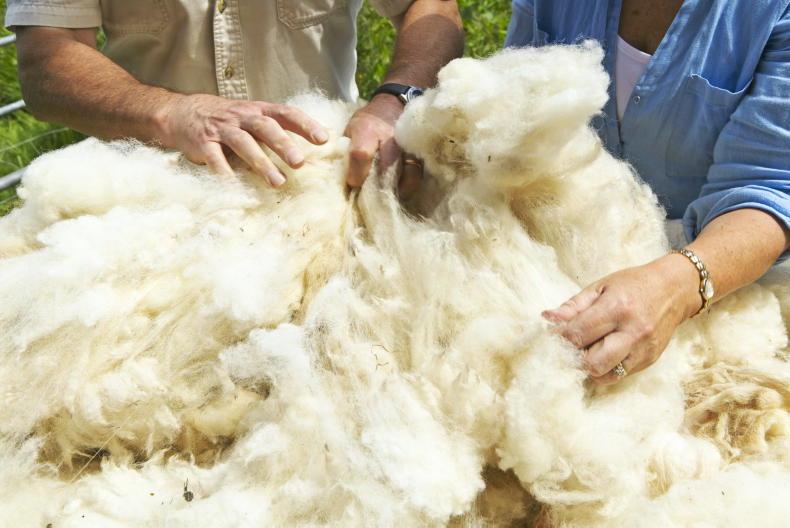
Any dags or foreign bodies must be removed from the wool before it goes into the bag. \ David Ruffles
Some of the land is rented and some is in forestry, while the rest is in mixed swards and used to graze her 40-strong flock. The farm is currently in organic conversion – so while she plans to increase the size of her flock, she will only do so with “due consideration to the land”.
Her admiration for the breed is obvious and it’s equally apparent when she talks about the Galway Sheep Breeders Association, which is the oldest association of its kind in Ireland.
“What I find amazing about this association is that they nearly reflect the breed themselves,” she smiles.

Blátnaid and Niall Gallagher, Farmers of Galway Sheep, Aughrim, Co Galway. \ David Ruffles
“They’re a docile bunch, hardworking, earnest and they have huge integrity. If you met the group, they’d have hundreds of stories to tell but there’s a shyness there too. They’re happy to just tick along quietly – doing their good work in keeping the breed alive.”
Bio-fibre
Blátnaid recently qualified from the National University of Ireland Galway (NUIG) with a master’s in agricultural innovation, which is a relatively new offering – it’s just finishing up its third year.

Galway sheep are friendly and docile. \ David Ruffles
“During the programme, you’re trying to create innovative initiatives in the agri sector in Ireland,” she explains. “This involves identifying a problem in the sector and then trying to find a solution. I identified the distorted Irish wool market as the problem, and my eureka moment was through the Galway Sheep Breeders Association. The provenance, as a native breed, already existed for the wool.”
Blátnaid hasn’t yet graduated (due to COVID-19), but says their graduation ceremony should happen this year.

Blátnaid is passionate about keeping the native breed going and creating a new route to market for Irish wool. \ David Ruffles
“I did get an honours master’s, though, and I think it’s because I was studying something I was quite passionate about,” she says. “Rural Irish communities can sometimes lack confidence. This course is creating the right mindset to make us believe we’re more than just farmers and it can make Ireland a far more innovative place at an agri level.”

Blátnaid and Niall also keep Connemara ponies – another native Irish breed – on their farm. \ David Ruffles
Galway Wool Co-op
As Blátnaid and Niall are well-travelled, we discuss how seeing other parts of the world can make you more appreciative of your own home and the traditions with which you were reared. Through the Galway sheep, Blátnaid has become equally passionate about preserving our traditional cottage industries.

Blátnaid and Niall Gallagher, Farmers of Galway Sheep, Aughrim, Co Galway. \ David Ruffles
Recently, she and other members of the Galway Sheep Breeders Society formed the Galway Wool Co-op, which has found an alternative route to market for Irish wool (they call it a bio-fibre). Founders of the co-op span as far as Kildare, Clare, Roscommon and Galway. There are Galway sheep breeders in all four provinces of Ireland. While many are commercial farmers, others simply have a passion to keep the breed going.
“The Galway fleece would have spun the first Aran sweater and would have developed the first of the cottage industries we have today,” she explains. “We have all these [different] sheep breeds that are producing meat really quickly, and then people are saying: ‘Well, we have to dump the wool.’
“You aren’t exploring the potential of a dual-purpose breed if that’s the case,” she continues. “You have sheep farmers going to the merchant with wool riddled with imperfections and expecting a decent price for it – the Galway Wool Co-op is creating better value through our respect for the wool of this beautiful heritage breed.”
Making their own luck
Conventional Irish wool is largely considered worthless (getting an average price of 20c/kg), and many Irish woolworkers, designers and craftspeople will tell you, if asked: “Irish wool can’t be sourced.”
The wool used to make most products sold in Ireland is imported and is mainly Merino.
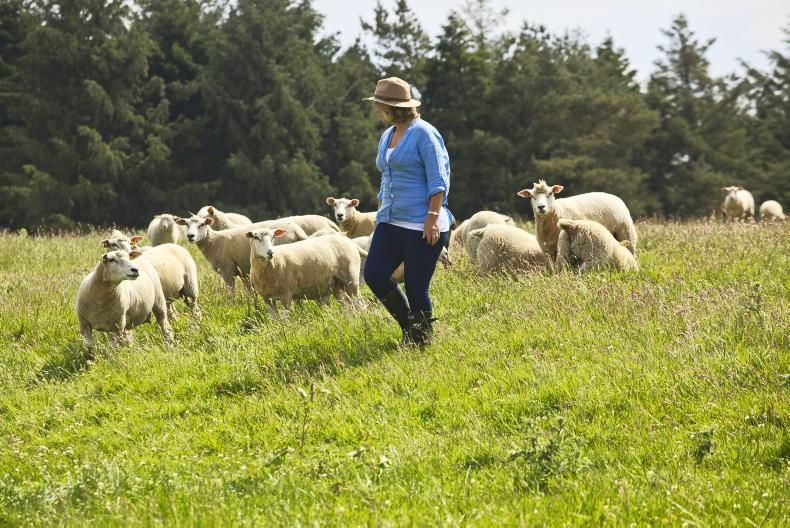
Blátnaid and Niall's farm is currently in organic conversion. \ David Ruffles
The aim of the Galway Wool Co-op, which was only established in early 2021, is to provide a local option for those who work with or sell wool products. As it was in the midst of the pandemic, the group started by holding their meetings via WhatsApp and Zoom.
“There are 10 founding members (some of us have never met in person) and we had the assistance of NUIG MSC student Matty Carroll. He did our feasibility study which enabled us to get funding from LEADER,” Blatnaid says.
“It just worked out that while Matty was doing a master’s we needed to get the feasibility study done. He refused to take payment so, as a gesture of goodwill, we offered him the chance to start his own flock with the gift of some purebred Galways – one ram and five ewe lambs.”
Buyers
Donegal Yarn will be purchasing its first round of Galway wool (5,000kg). They will process the raw material and already have two subsequent buyers in place – Michael Burke, who runs a business called Woolow (specialising in organic wool pillows) and an Irish-New York-based home interiors designer. Blátnaid says the co-op will be making 10 times the current market value of conventional Irish wool – though the co-op will initially put aside a levy to cover start-up costs.

The sheep are good for meat, wool and are naturally good and protective mothers. \ David Ruffles
“Us processing the wool was never part of the business plan,” she explains. “We were looking for a client willing to do that themselves and we’ve found that with Donegal Yarn. The promotion of the breed and the wool is our priority for now.”
As to maintaining a high-quality product, co-op members must make as few markings on the sheep as possible prior to shearing. Then, at shearing, it is crucial that all dags, imperfections and foreign bodies are removed before the wool goes into the bag. They only sell 100% purebred Galway wool and have access to experts who can confirm the wool is purebred.
Farm finances
“We’re investing in this farm so we need to make the wool work,” Blátnaid says. “The wool has to pay for the privilege of farming sustainably, and so we can sleep at night being custodians of this land.”
“We planted forestry over there because we’re thinking of the future – 25ac planted with new forest and it’s now in its fifth year,” Niall adds.
“We’re thinking that as these grow you can replace them but it also generates an income down the line which could even, logistically, work as a pension.”
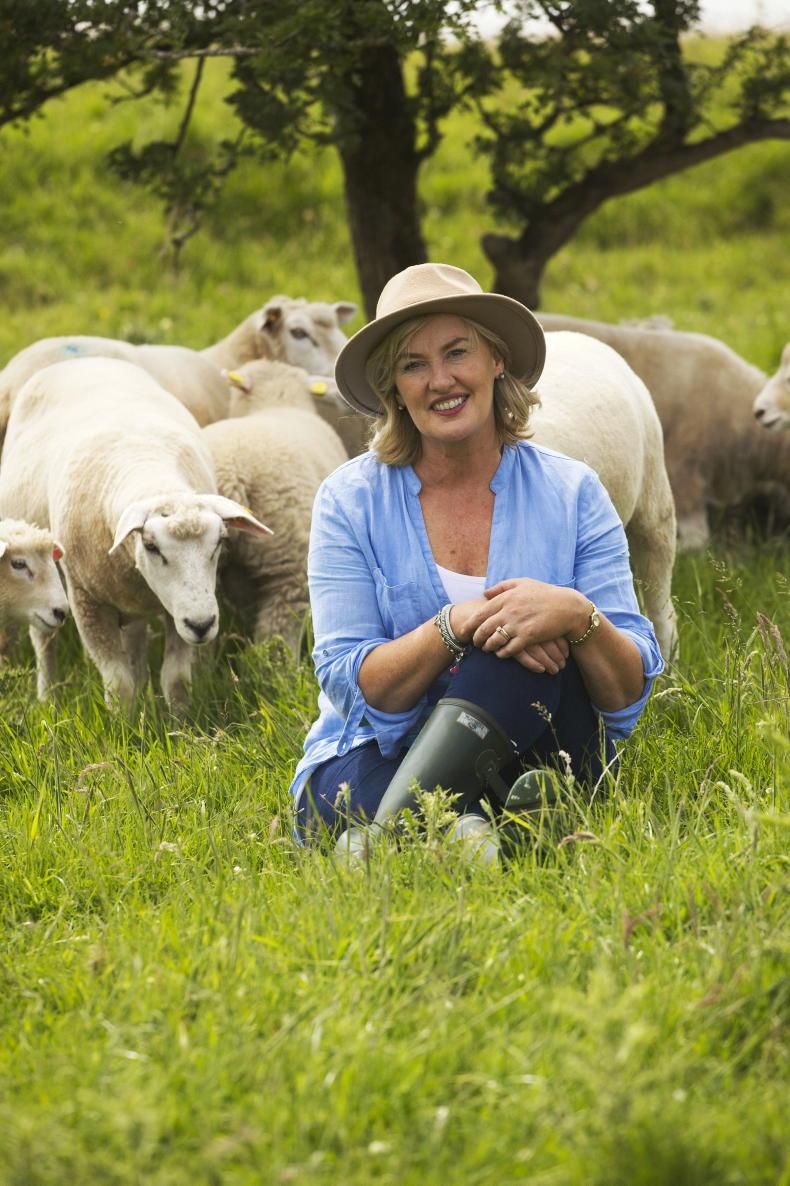
Blátnaid recently qualified in agricultural innovation from NUIG. \ David Ruffles
“We breed white geese; they’re going in the organic scheme as well and while we’re in conversion I’ve been selling the eggs,” Blatnaid says.
“They’ve been hatched out all over Ireland this summer. We keep Connemara ponies as well, so we hope to be able to breed another native species here. We have several enterprises on farm really.”
“We’ve lived the life. We’ve had several trips around the world several times. We’ve seen the good hotels and dined in the nice restaurants. Having done all that it’s nice to come back and exhale. We’ve done it.”
Ask if it’s Irish
Blátnaid and the co-op want Irish consumers to start asking about the provenance of wool in shops – where is it coming from?
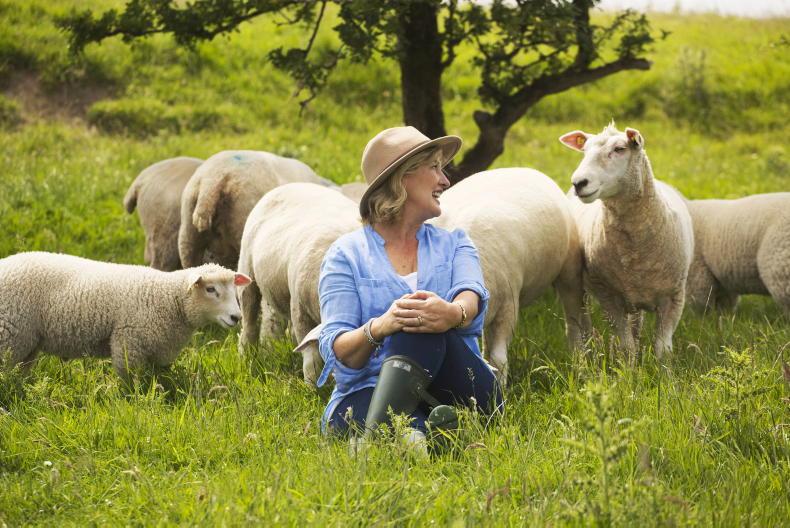
Blátnaid says Galway sheep are inquisitive and intelligent. \ David Ruffles
“We do not have Merino sheep producing wool in Ireland,” she says. “We hope when consumers are on holiday, at the local tourist shop, they can ask: ‘Is that Galway wool? Is it Irish wool?’ Suggest that the retailer might add a special section to their shop for Irish wool.”
“Farmers are notorious for not liking paperwork but it does have its uses.”
I’m speaking with Co Galway farmer Blátnaid Gallagher and her husband Niall.
We’re picnicking in one of their fields near the historic village of Aughrim, drinking strong tea from a flask and eating scones with cream and jam.
As we eat, their inquisitive flock of Galway sheep (freshly shorn) are approaching – wondering if they might get a bite of scone, as well.

Galway sheep don't tend to wander, making them ideal for pasture grazing. \ David Ruffles
Yes, paperwork can be boring but for a native Irish breed it’s the raison d’être. Galway sheep, with their pleasant nature and cute hair-dos, have been meticulously documented for over 100 years; proving a clear lineage and existence. Blátnaid started farming her “Galway girls” five years ago and she is a passionate advocate for the breed and its continued survival.
A native Irish breed
She says, historically, there were two main groups of sheep native to Ireland: one prevalent in the uplands, and the other in the lowland plains.
However, the Galway sheep is currently the only listed native breed in the eyes of the Department of Agriculture and the Marine (DAFM), as its ancestry can be tracked over several generations through the Galway Sheep Breeders Association (established in 1923).

Blátnaid and Niall are meticulous about how their sheep are sheared. \ David Ruffles
“There was a breed of sheep that was predominant over the plains of Ireland (the lowland sheep),” she says. “In the early 19th century, a group of farmers in Roscommon got together and formed the first flock book of Irish lowland sheep breed, called the Roscommon.
“However,” she continues, “they didn’t pursue it and that flock book was lost. In 1923, a group of farmers in Galway got their own flock book together. So, the Roscommon disappeared – and it’s highly likely the Roscommon and the Galway are the same lowland Irish sheep. Because the Galway flock book was maintained, it’s the Galway which has the recognition of a native Irish breed.”

The Galway wool is bright white and extremely soft. \ David Ruffles
Galway Sheep Breeders Association
Blátnaid became involved in the Galway Sheep Breeders Association when she started keeping her own Galways. She inherited her family farm, which is over 100ac in size.

Any dags or foreign bodies must be removed from the wool before it goes into the bag. \ David Ruffles
Some of the land is rented and some is in forestry, while the rest is in mixed swards and used to graze her 40-strong flock. The farm is currently in organic conversion – so while she plans to increase the size of her flock, she will only do so with “due consideration to the land”.
Her admiration for the breed is obvious and it’s equally apparent when she talks about the Galway Sheep Breeders Association, which is the oldest association of its kind in Ireland.
“What I find amazing about this association is that they nearly reflect the breed themselves,” she smiles.

Blátnaid and Niall Gallagher, Farmers of Galway Sheep, Aughrim, Co Galway. \ David Ruffles
“They’re a docile bunch, hardworking, earnest and they have huge integrity. If you met the group, they’d have hundreds of stories to tell but there’s a shyness there too. They’re happy to just tick along quietly – doing their good work in keeping the breed alive.”
Bio-fibre
Blátnaid recently qualified from the National University of Ireland Galway (NUIG) with a master’s in agricultural innovation, which is a relatively new offering – it’s just finishing up its third year.

Galway sheep are friendly and docile. \ David Ruffles
“During the programme, you’re trying to create innovative initiatives in the agri sector in Ireland,” she explains. “This involves identifying a problem in the sector and then trying to find a solution. I identified the distorted Irish wool market as the problem, and my eureka moment was through the Galway Sheep Breeders Association. The provenance, as a native breed, already existed for the wool.”
Blátnaid hasn’t yet graduated (due to COVID-19), but says their graduation ceremony should happen this year.

Blátnaid is passionate about keeping the native breed going and creating a new route to market for Irish wool. \ David Ruffles
“I did get an honours master’s, though, and I think it’s because I was studying something I was quite passionate about,” she says. “Rural Irish communities can sometimes lack confidence. This course is creating the right mindset to make us believe we’re more than just farmers and it can make Ireland a far more innovative place at an agri level.”

Blátnaid and Niall also keep Connemara ponies – another native Irish breed – on their farm. \ David Ruffles
Galway Wool Co-op
As Blátnaid and Niall are well-travelled, we discuss how seeing other parts of the world can make you more appreciative of your own home and the traditions with which you were reared. Through the Galway sheep, Blátnaid has become equally passionate about preserving our traditional cottage industries.

Blátnaid and Niall Gallagher, Farmers of Galway Sheep, Aughrim, Co Galway. \ David Ruffles
Recently, she and other members of the Galway Sheep Breeders Society formed the Galway Wool Co-op, which has found an alternative route to market for Irish wool (they call it a bio-fibre). Founders of the co-op span as far as Kildare, Clare, Roscommon and Galway. There are Galway sheep breeders in all four provinces of Ireland. While many are commercial farmers, others simply have a passion to keep the breed going.
“The Galway fleece would have spun the first Aran sweater and would have developed the first of the cottage industries we have today,” she explains. “We have all these [different] sheep breeds that are producing meat really quickly, and then people are saying: ‘Well, we have to dump the wool.’
“You aren’t exploring the potential of a dual-purpose breed if that’s the case,” she continues. “You have sheep farmers going to the merchant with wool riddled with imperfections and expecting a decent price for it – the Galway Wool Co-op is creating better value through our respect for the wool of this beautiful heritage breed.”
Making their own luck
Conventional Irish wool is largely considered worthless (getting an average price of 20c/kg), and many Irish woolworkers, designers and craftspeople will tell you, if asked: “Irish wool can’t be sourced.”
The wool used to make most products sold in Ireland is imported and is mainly Merino.

Blátnaid and Niall's farm is currently in organic conversion. \ David Ruffles
The aim of the Galway Wool Co-op, which was only established in early 2021, is to provide a local option for those who work with or sell wool products. As it was in the midst of the pandemic, the group started by holding their meetings via WhatsApp and Zoom.
“There are 10 founding members (some of us have never met in person) and we had the assistance of NUIG MSC student Matty Carroll. He did our feasibility study which enabled us to get funding from LEADER,” Blatnaid says.
“It just worked out that while Matty was doing a master’s we needed to get the feasibility study done. He refused to take payment so, as a gesture of goodwill, we offered him the chance to start his own flock with the gift of some purebred Galways – one ram and five ewe lambs.”
Buyers
Donegal Yarn will be purchasing its first round of Galway wool (5,000kg). They will process the raw material and already have two subsequent buyers in place – Michael Burke, who runs a business called Woolow (specialising in organic wool pillows) and an Irish-New York-based home interiors designer. Blátnaid says the co-op will be making 10 times the current market value of conventional Irish wool – though the co-op will initially put aside a levy to cover start-up costs.

The sheep are good for meat, wool and are naturally good and protective mothers. \ David Ruffles
“Us processing the wool was never part of the business plan,” she explains. “We were looking for a client willing to do that themselves and we’ve found that with Donegal Yarn. The promotion of the breed and the wool is our priority for now.”
As to maintaining a high-quality product, co-op members must make as few markings on the sheep as possible prior to shearing. Then, at shearing, it is crucial that all dags, imperfections and foreign bodies are removed before the wool goes into the bag. They only sell 100% purebred Galway wool and have access to experts who can confirm the wool is purebred.
Farm finances
“We’re investing in this farm so we need to make the wool work,” Blátnaid says. “The wool has to pay for the privilege of farming sustainably, and so we can sleep at night being custodians of this land.”
“We planted forestry over there because we’re thinking of the future – 25ac planted with new forest and it’s now in its fifth year,” Niall adds.
“We’re thinking that as these grow you can replace them but it also generates an income down the line which could even, logistically, work as a pension.”

Blátnaid recently qualified in agricultural innovation from NUIG. \ David Ruffles
“We breed white geese; they’re going in the organic scheme as well and while we’re in conversion I’ve been selling the eggs,” Blatnaid says.
“They’ve been hatched out all over Ireland this summer. We keep Connemara ponies as well, so we hope to be able to breed another native species here. We have several enterprises on farm really.”
“We’ve lived the life. We’ve had several trips around the world several times. We’ve seen the good hotels and dined in the nice restaurants. Having done all that it’s nice to come back and exhale. We’ve done it.”
Ask if it’s Irish
Blátnaid and the co-op want Irish consumers to start asking about the provenance of wool in shops – where is it coming from?

Blátnaid says Galway sheep are inquisitive and intelligent. \ David Ruffles
“We do not have Merino sheep producing wool in Ireland,” she says. “We hope when consumers are on holiday, at the local tourist shop, they can ask: ‘Is that Galway wool? Is it Irish wool?’ Suggest that the retailer might add a special section to their shop for Irish wool.”




















 This is a subscriber-only article
This is a subscriber-only article










SHARING OPTIONS: